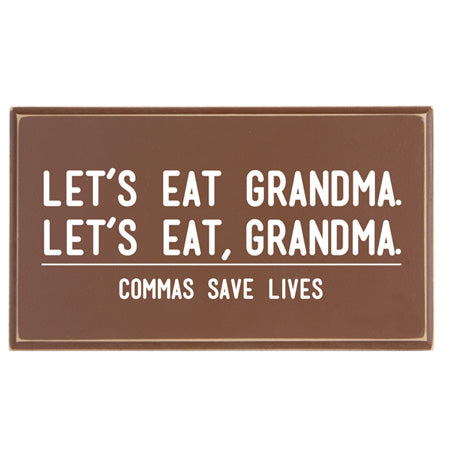Commas can be a real b***h!
It's rare to find a writer who can use commas perfectly. Truth be told, commas are much harder to use than almost any other punctuation. It's hard to know when to use a comma instead of a hyphen, a colon, or a semi-colon.
Here's everything you need to know about commas (taken from The Writing Center, courtesy of the University of Wisconsin)…
We use commas to signal nonrestrictive or nonessential material, to prevent confusion, and to indicate relationships among ideas and sentence parts.
GOOD Example:
When choosing a ballroom dancing partner, it's wise to find one who has both a left and right foot.
The party people, who were all drunk, threw themselves into the Jell-O filled limousine.
Overdoing it with commas makes a sentence REALLY hard to read.
BAD Example:
Bob, Jane, and Mary, three friends from, Harvard, enjoyed an afternoon of, flaying.
The name, "Wilhelmina," is one of the most beautiful names, in German cuisine.
Commas are used to join two dependent clauses.
GOOD Example:
While I prefer to eat applesauce, Bob prefers the tails of small rodents for dinner.
Commas do not join two independent thoughts.
BAD Example:
Mary and Paul decided to visit the morgue, Bob had a laugh at John's expense.
 Here are a few more rules of comma use (courtesy of Purdue University)
Use commas to separate independent clauses when they are joined by any of these seven coordinating conjunctions: and, but, for, or, nor, so, yet.
Use commas after introductory a) clauses, b) phrases, or c) words that come before the main clause.
Use a pair of commas in the middle of a sentence to set off clauses, phrases, and words that are not essential to the meaning of the sentence. Use one comma before to indicate the beginning of the pause and one at the end to indicate the end of the pause.
Do not use commas to set off essential elements of the sentence, such as clauses beginning with that (relative clauses). That clauses after nouns are always essential. That clauses following a verb expressing mental action are always essential
Use commas to separate three or more words, phrases, or clauses written in a series.
Use commas to separate two or more coordinate adjectives that describe the same noun. Be sure never to add an extra comma between the final adjective and the noun itself or to use commas with non-coordinate adjectives.
Use a comma near the end of a sentence to separate contrasted coordinate elements or to indicate a distinct pause or shift.
Use commas to set off phrases at the end of the sentence that refer to the beginning or middle of the sentence. Such phrases are free modifiers that can be placed anywhere in the sentence without causing confusion. (If the placement of the modifier causes confusion, then it is not "free" and must remain "bound" to the word it modifies.)
Use commas to set off all geographical names, items in dates (except the month and day), addresses (except the street number and name), and titles in names.
Use a comma to shift between the main discourse and a quotation.
Use commas wherever necessary to prevent possible confusion or misreading.
(Source: Purdue University)
Use these comma rules to NEVER make a comma mistake again. Or, at the very least, try to reduce those errors!
Here are a few more rules of comma use (courtesy of Purdue University)
Use commas to separate independent clauses when they are joined by any of these seven coordinating conjunctions: and, but, for, or, nor, so, yet.
Use commas after introductory a) clauses, b) phrases, or c) words that come before the main clause.
Use a pair of commas in the middle of a sentence to set off clauses, phrases, and words that are not essential to the meaning of the sentence. Use one comma before to indicate the beginning of the pause and one at the end to indicate the end of the pause.
Do not use commas to set off essential elements of the sentence, such as clauses beginning with that (relative clauses). That clauses after nouns are always essential. That clauses following a verb expressing mental action are always essential
Use commas to separate three or more words, phrases, or clauses written in a series.
Use commas to separate two or more coordinate adjectives that describe the same noun. Be sure never to add an extra comma between the final adjective and the noun itself or to use commas with non-coordinate adjectives.
Use a comma near the end of a sentence to separate contrasted coordinate elements or to indicate a distinct pause or shift.
Use commas to set off phrases at the end of the sentence that refer to the beginning or middle of the sentence. Such phrases are free modifiers that can be placed anywhere in the sentence without causing confusion. (If the placement of the modifier causes confusion, then it is not "free" and must remain "bound" to the word it modifies.)
Use commas to set off all geographical names, items in dates (except the month and day), addresses (except the street number and name), and titles in names.
Use a comma to shift between the main discourse and a quotation.
Use commas wherever necessary to prevent possible confusion or misreading.
(Source: Purdue University)
Use these comma rules to NEVER make a comma mistake again. Or, at the very least, try to reduce those errors!
 Here are a few more rules of comma use (courtesy of Purdue University)
Use commas to separate independent clauses when they are joined by any of these seven coordinating conjunctions: and, but, for, or, nor, so, yet.
Use commas after introductory a) clauses, b) phrases, or c) words that come before the main clause.
Use a pair of commas in the middle of a sentence to set off clauses, phrases, and words that are not essential to the meaning of the sentence. Use one comma before to indicate the beginning of the pause and one at the end to indicate the end of the pause.
Do not use commas to set off essential elements of the sentence, such as clauses beginning with that (relative clauses). That clauses after nouns are always essential. That clauses following a verb expressing mental action are always essential
Use commas to separate three or more words, phrases, or clauses written in a series.
Use commas to separate two or more coordinate adjectives that describe the same noun. Be sure never to add an extra comma between the final adjective and the noun itself or to use commas with non-coordinate adjectives.
Use a comma near the end of a sentence to separate contrasted coordinate elements or to indicate a distinct pause or shift.
Use commas to set off phrases at the end of the sentence that refer to the beginning or middle of the sentence. Such phrases are free modifiers that can be placed anywhere in the sentence without causing confusion. (If the placement of the modifier causes confusion, then it is not "free" and must remain "bound" to the word it modifies.)
Use commas to set off all geographical names, items in dates (except the month and day), addresses (except the street number and name), and titles in names.
Use a comma to shift between the main discourse and a quotation.
Use commas wherever necessary to prevent possible confusion or misreading.
(Source: Purdue University)
Use these comma rules to NEVER make a comma mistake again. Or, at the very least, try to reduce those errors!
Here are a few more rules of comma use (courtesy of Purdue University)
Use commas to separate independent clauses when they are joined by any of these seven coordinating conjunctions: and, but, for, or, nor, so, yet.
Use commas after introductory a) clauses, b) phrases, or c) words that come before the main clause.
Use a pair of commas in the middle of a sentence to set off clauses, phrases, and words that are not essential to the meaning of the sentence. Use one comma before to indicate the beginning of the pause and one at the end to indicate the end of the pause.
Do not use commas to set off essential elements of the sentence, such as clauses beginning with that (relative clauses). That clauses after nouns are always essential. That clauses following a verb expressing mental action are always essential
Use commas to separate three or more words, phrases, or clauses written in a series.
Use commas to separate two or more coordinate adjectives that describe the same noun. Be sure never to add an extra comma between the final adjective and the noun itself or to use commas with non-coordinate adjectives.
Use a comma near the end of a sentence to separate contrasted coordinate elements or to indicate a distinct pause or shift.
Use commas to set off phrases at the end of the sentence that refer to the beginning or middle of the sentence. Such phrases are free modifiers that can be placed anywhere in the sentence without causing confusion. (If the placement of the modifier causes confusion, then it is not "free" and must remain "bound" to the word it modifies.)
Use commas to set off all geographical names, items in dates (except the month and day), addresses (except the street number and name), and titles in names.
Use a comma to shift between the main discourse and a quotation.
Use commas wherever necessary to prevent possible confusion or misreading.
(Source: Purdue University)
Use these comma rules to NEVER make a comma mistake again. Or, at the very least, try to reduce those errors!

